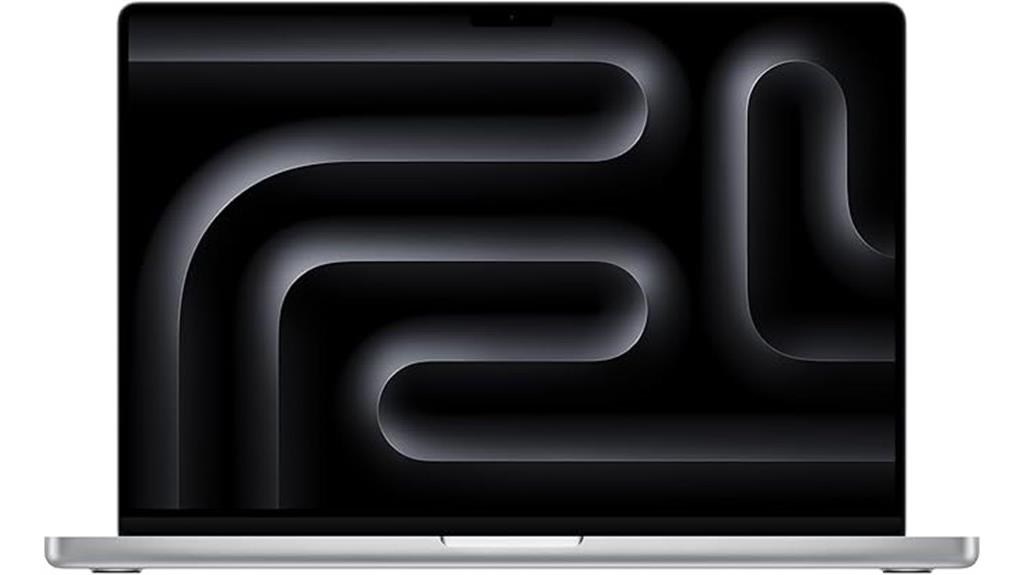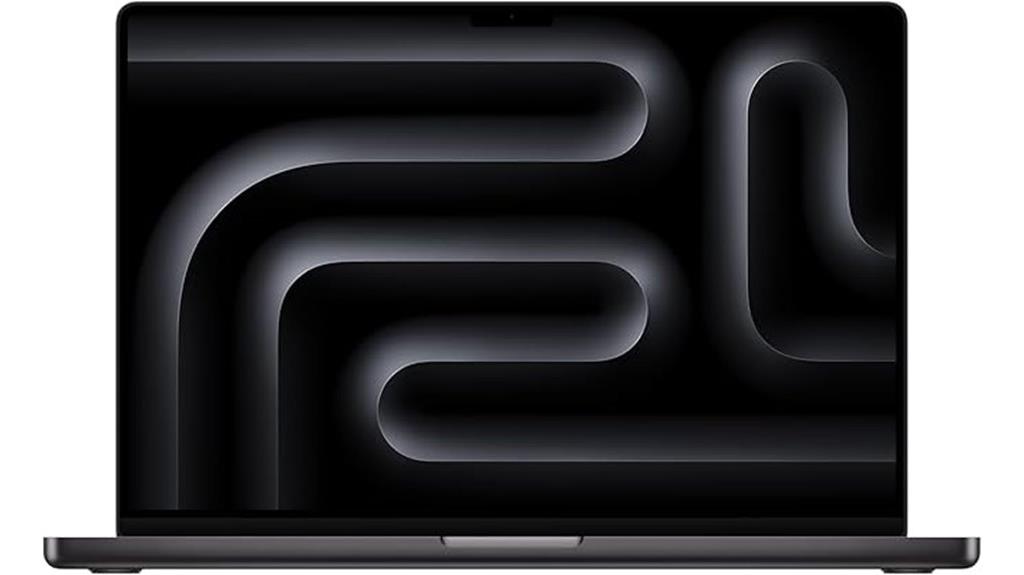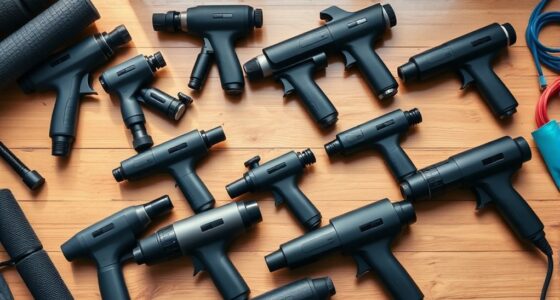Based on what experts say in 2025, the top MacBook Pro models for data science and AI feature the powerful M4 Max chip, offering up to 40-core GPUs and high-core CPUs, perfect for heavy workloads. They come with at least 16GB RAM, extensive storage, and stunning Liquid Retina XDR displays for detailed visuals. Portability combined with long battery life makes them a go-to for demanding projects. Stay with me to explore the full list and what makes each model ideal.
Key Takeaways
- Models featuring the M4 Max chip with 12-core or 16-core CPUs and 40-core GPUs provide exceptional processing power for AI and data science tasks.
- Configurations with 32GB to 64GB RAM ensure smooth handling of large datasets and complex models, reducing bottlenecks.
- High-resolution Liquid Retina XDR displays with up to 1600 nits brightness enable detailed visualization of data and models.
- Portability combined with extensive connectivity options like Thunderbolt 5 and SDXC slots supports external storage and peripherals.
- Premium build quality, long battery life, and advanced media engines make these MacBook Pros ideal for demanding AI and data science workflows.
Apple 2024 MacBook Pro with M4 Max Chip 16-inch (Renewed)

If you’re looking for a powerful, portable machine to handle demanding data science and AI tasks, the Apple 2024 MacBook Pro with M4 Max chip is an ideal choice. Its 16-inch Liquid Retina XDR display offers vibrant visuals with up to 1600 nits brightness, perfect for detailed work. Equipped with 36GB RAM and a 1TB SSD, it manages intensive workflows like 3D rendering and code compilation smoothly. The M4 Max chip provides exceptional performance, and macOS ensures seamless app use. Weighing just under 5 pounds, it combines portability with professional-grade power, making it a reliable tool for serious data and AI projects.
Best For: professionals and enthusiasts in data science, AI development, 3D rendering, and demanding creative workflows seeking portable yet powerful computing.
Pros:
- Exceptional performance with M4 Max chip and 36GB RAM, ideal for intensive tasks
- Stunning 16.2-inch Liquid Retina XDR display with high brightness and vivid visuals
- Seamless integration within the Apple ecosystem enhances productivity and user experience
Cons:
- Weighs nearly 5 pounds, which may impact portability for some users
- Premium price point, even as a renewed product, could be prohibitive for budget-conscious buyers
- Limited upgrade options post-purchase due to integrated hardware design
Apple MacBook Pro 2024 with M4 Chip (14.2-inch Liquid Retina XDR, 16GB RAM, 1TB SSD, Space Black)

The Apple MacBook Pro 2024 with M4 chip stands out as an ideal choice for data scientists and AI professionals thanks to its powerful 10-core CPU and GPU, which deliver exceptional performance for demanding workloads. Its 14.2-inch Liquid Retina XDR display offers stunning visuals with 1,000,000:1 contrast and up to 1600 nits brightness, perfect for data visualization. With 16GB of RAM and a 1TB SSD, it handles multitasking and large datasets smoothly. The sleek Space Black design, combined with extensive connectivity options like Thunderbolt ports, HDMI, and SDXC slot, makes it versatile for both work and portability, all while supporting long battery life.
Best For: Data scientists, AI professionals, and creative professionals seeking powerful performance, stunning visuals, and versatile connectivity in a portable, sleek design.
Pros:
- Exceptional processing power with 10-core CPU and GPU, ideal for demanding workloads
- Stunning Liquid Retina XDR display with high contrast and brightness for immersive visuals
- Long battery life supports extended work sessions and portability
Cons:
- Premium price point may be costly for some users
- Limited to macOS, which may not suit all software preferences or workflows
- No AV1 hardware decode support, potentially affecting compatibility with certain video formats
Apple 2024 MacBook Pro Laptop with M4 Max

For professionals working with demanding data science and AI workflows, the 2024 MacBook Pro with M4 Max offers unmatched processing power and advanced graphics capabilities. Its M4 Max chip excels at handling complex workflows like 3D rendering and large-scale data analysis, ensuring smooth performance. The 16.2-inch Liquid Retina XDR display delivers stunning visuals with high brightness and contrast, ideal for creative and analytical tasks. With up to four external displays, 36GB of unified memory, and extensive connectivity options, this model supports intensive multitasking. Built for all-day use, it combines power, portability, and seamless integration within the Apple ecosystem, making it a top choice for data scientists and AI professionals.
Best For: professionals and creatives who require powerful processing, advanced graphics, and seamless multitasking for data science, AI workflows, 3D rendering, and multimedia tasks.
Pros:
- Exceptional performance with M4 Max chip handling demanding workflows with ease
- Stunning 16.2-inch Liquid Retina XDR display with high brightness and contrast for detailed visuals
- Extensive connectivity including multiple Thunderbolt 5 ports and support for up to four external displays
Cons:
- High cost may be prohibitive for some users
- Large size and weight could impact portability for on-the-go use
- Limited to professional users needing high-end specifications, not ideal for casual users
Apple 2024 MacBook Pro Laptop with M4 Max

The Apple 2024 MacBook Pro with M4 Max stands out as an excellent choice for data scientists and AI developers needing raw processing power and high-resolution displays. Its 14-core CPU, 32-core GPU (upgradable to 40-core), and 16-core Neural Engine handle demanding tasks like code compilation, 3D rendering, and media editing effortlessly. The Liquid Retina XDR display offers stunning visuals with 1 billion colors and up to 1600 nits brightness. With up to 128GB of RAM and 8TB storage, it’s built for extensive data workloads. Its versatile ports, long battery life, and seamless Apple ecosystem integration make it a top-tier machine for advanced AI and data science work.
Best For: data scientists, AI developers, and creative professionals seeking powerful processing, high-resolution visuals, and seamless Apple ecosystem integration.
Pros:
- Exceptional performance with M4 Max chip, ideal for demanding AI and data workloads
- Stunning Liquid Retina XDR display with high brightness and color accuracy
- Versatile connectivity options including Thunderbolt 5, HDMI, SDXC, and MagSafe 3
Cons:
- High price point may be a barrier for some users
- Weight and size could impact portability for frequent travelers
- Limited upgradeability after purchase due to integrated components
Apple MacBook Pro Laptop with M4 Max (2024)

If you’re working on demanding data science or AI projects, the 2024 MacBook Pro with M4 Max is an excellent choice thanks to its powerful 40-core GPU and up to 128GB of RAM. Its 16.2-inch Liquid Retina XDR display offers stunning visuals with high brightness, contrast, and true color accuracy, ideal for visualizing complex data. The M4 Max chip provides a 16-core CPU, hardware-accelerated ray tracing, and advanced media engines, making intensive workflows like 3D rendering and media editing smooth. With extensive connectivity options and up to 21 hours of battery life, this laptop combines power, portability, and versatility for professional data scientists and AI developers.
Best For: creative professionals, data scientists, and AI developers who need a powerful, portable laptop with exceptional display quality and extensive connectivity options.
Pros:
- High-performance M4 Max chip with a 40-core GPU and up to 128GB of RAM for demanding workflows
- Stunning 16.2-inch Liquid Retina XDR display with high brightness, contrast, and true color accuracy
- Long battery life of up to 21 hours combined with multiple ports including Thunderbolt 5, HDMI, and SDXC card slot
Cons:
- Premium price point may be prohibitive for some users
- Slightly heavy at 4.73 pounds, which may impact portability for some users
- Limited to macOS ecosystem, which may not suit users preferring Windows or other OS options
Factors to Consider When Choosing a Macbook Pro for Data Science and AI

When selecting a MacBook Pro for data science and AI, I focus on key factors like processor power, RAM, and GPU strength, since these directly impact performance. Storage capacity and expandability are also vital for managing large datasets and software, while a bright, high-quality display helps with detailed analysis. Understanding these points guarantees I choose a model that meets my specific computational and workflow needs.
Processor Power and Cores
Choosing a MacBook Pro with a powerful processor is essential for handling data science and AI tasks efficiently. Higher core counts boost parallel processing, which is fundamental when working with complex models and large datasets. A 12-core or 16-core CPU can greatly reduce training and inference times, saving you valuable time. The combination of performance cores and efficiency cores strikes a balance between power and battery life, allowing demanding tasks without draining your battery. More cores also improve multitasking, so you can run multiple data analysis or AI training processes simultaneously without slowdown. High-core-count processors ensure that your MacBook Pro can handle resource-intensive applications like machine learning frameworks and large datasets smoothly, making it a key factor in selecting the right machine for your data science and AI needs.
RAM and Memory Capacity
RAM and memory capacity are essential factors to contemplate because they directly impact how efficiently your MacBook Pro can handle data science and AI workloads. For these tasks, I recommend at least 16GB of RAM to manage large datasets and complex models smoothly. Upgrading to 32GB or more notably boosts performance during multitasking and when running memory-intensive applications like TensorFlow or PyTorch. Higher memory reduces the need for virtual memory swapping, which speeds up data preprocessing and model training. If you’re working on large-scale AI projects involving extensive data manipulation or simulations, 64GB or more is ideal. Adequate RAM ensures multiple data science tools operate seamlessly, preventing lag or crashes during intensive workflows. Investing in higher memory capacity is essential for peak performance in demanding AI and data science applications.
Graphics and GPU Strength
A powerful GPU can dramatically improve the performance of data science and AI tasks on a MacBook Pro. A 32-core or higher GPU accelerates machine learning model training and data processing, making complex computations faster and more efficient. The GPU’s strength directly affects how well the Mac handles large datasets and sophisticated neural networks, vital for advanced AI workflows. High-end graphics processors enable hardware-accelerated ray tracing and support parallel computations, which are essential for visualizations and simulations. Multiple GPU cores improve multitasking, allowing smoother operation when running resource-intensive applications like deep learning frameworks. Investing in a MacBook Pro with a robust GPU ensures you can manage demanding tasks without lag, ultimately boosting productivity and enabling advanced data science and AI work on the go.
Storage and Expansion Options
Since data science and AI projects often involve handling large datasets and complex models, it’s essential to prioritize storage and expansion options when choosing a MacBook Pro. I recommend selecting a model with at least 1TB of SSD storage to manage sizable datasets efficiently. For even more capacity, look for configurations offering up to 8TB of SSD storage. External storage support via Thunderbolt or USB-C ports is also crucial, allowing you to expand storage easily. Additionally, consider models that support memory upgrades—48GB or more—so you can handle memory-intensive tasks alongside storage needs. Multiple ports like SDXC, HDMI, and Thunderbolt 5 are practical for connecting external drives and expansion accessories, ensuring your workspace remains flexible and scalable as your projects grow.
Display Quality and Brightness
Choosing a MacBook Pro with exceptional display quality is crucial for data science and AI work, where clear visualization of complex datasets and models makes all the difference. A high-resolution display with at least 3024×1964 pixels ensures detailed visualization, capturing even the smallest data points. An XDR display with peak brightness of 1000 nits or more improves visibility in bright environments and HDR content. Support for the P3 wide color gamut guarantees accurate color representation, indispensable for precise data visualization and graphics tasks. The ProMotion technology offering up to 120Hz refresh rate ensures smooth scrolling and real-time updates, boosting productivity. Brightness peaks of 1600 nits, combined with high contrast ratios, enhance clarity in media-rich or graph-heavy datasets, making complex data easier to interpret.
Battery Life and Portability
When working on data science and AI projects, battery life and portability can make or break your workflow. Long-lasting batteries let me analyze data or train models without frequent recharges, especially during fieldwork or remote work. A high-capacity battery, like 100Wh or more, supports intensive tasks while keeping my MacBook Pro portable. Slim, lightweight designs are essential for carrying the device between locations or during travel, enhancing productivity on the go. A portable MacBook Pro ensures I can work seamlessly from various environments, saving time and reducing interruptions. Of course, battery performance depends on workload, so choosing models with efficient chips and optimized power management is vital for sustained mobility and smooth project execution.
Connectivity and External Support
Having the right connectivity options on a MacBook Pro is essential for smooth data science and AI workflows. I look for models with multiple Thunderbolt 4 or Thunderbolt 5 ports to support high-speed data transfer and connect multiple external devices simultaneously. An HDMI port and SDXC card slot are critical for connecting cameras, external displays, and transferring data from media devices efficiently. I also verify that the MacBook supports daisy-chaining multiple external displays, especially for multi-monitor setups. Compatibility with high-bandwidth peripherals like external GPUs or specialized data acquisition hardware is a must, usually via Thunderbolt or USB-C ports. Finally, fast charging and reliable wireless connections like Wi-Fi 6E and Bluetooth 5.3 are essential for seamless integration of all external devices and smooth workflow management.
Frequently Asked Questions
How Does the M4 Chip Improve Data Processing Speed?
The M4 chip boosts data processing speed by using a more advanced architecture that enhances multitasking and computational power. It features faster cores and improved efficiency, which means I can handle large datasets and complex AI models more quickly. The integrated neural engine accelerates machine learning tasks, reducing wait times. Overall, the M4 chip makes my workflow smoother and more efficient, especially when working with intensive data science applications.
What Are the Battery Life Expectations for AI Workloads?
Imagine your MacBook Pro’s battery as a steady river, flowing smoothly through long AI workloads. Typically, I’d expect around 8-12 hours of life, depending on task intensity. Light data processing eats less power, while heavy AI training shortens that window. So, plan for a full day’s work, with some room to spare. Keep in mind, real-world usage varies, but these are solid benchmarks to rely on.
How Does RAM Capacity Impact Large Dataset Analysis?
Higher RAM capacity crucially boosts my ability to analyze large datasets efficiently. It allows me to keep more data in memory, reducing the need to swap to slower storage, which speeds up processing times. With ample RAM, I can run complex models and handle multiple applications simultaneously without performance issues. So, for big data tasks, I always prefer a MacBook Pro with maximum RAM to guarantee smooth, fast analysis.
Are There Specific Ports Optimal for AI Hardware Connections?
Think of ports like roads connecting your AI hardware to your MacBook. For ideal connections, Thunderbolt 4 or USB-C ports are like highways, offering fast, versatile links for external GPUs, high-speed drives, and other peripherals. I always recommend ensuring your MacBook has multiple Thunderbolt ports, so you can seamlessly connect powerful AI hardware without bottlenecks. It’s like having a well-extended highway system for your data to travel swiftly.
How Do Cooling Systems Affect Sustained AI Performance?
Cooling systems are vital for sustained AI performance because they prevent overheating, which can throttle the processor and reduce efficiency. When my laptop’s cooling is effective, I notice my tasks run smoothly without slowdown, even during intensive computations. Proper cooling allows the hardware to maintain ideal speeds longer, ensuring consistent results and preventing crashes. So, investing in good cooling solutions directly boosts my AI workflows’ reliability and speed.
Conclusion
Ultimately, choosing the right MacBook Pro for data science and AI comes down to matching your needs with power and performance. The best models offer top-tier processors, ample RAM, and fast storage — essentials for heavy workloads. Remember, a chain is only as strong as its weakest link, so investing in a machine that can handle your tasks guarantees smoother workflows. Pick wisely, and you’ll be set for success ahead.









